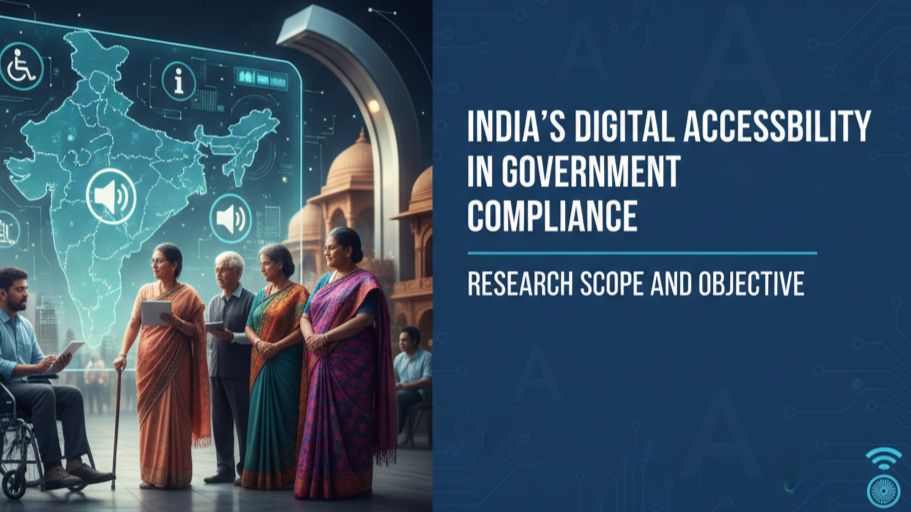Define the Research Scope and Objective

A. Problem Statement
India has a comprehensive legal and standards framework for digital accessibility, the Rights of Persons with Disabilities (RPwD) Act, 2016; the notification of IS-17802 (ICT Accessibility Standards); and the Government of India’s GIGW 3.0 guidelines. Collectively, these establish accessibility as both a legal right and a technical requirement for all government websites and mobile applications.
However, compliance remains fragmented. Central government portals often show higher levels of adoption (partly due to visibility and monitoring by NIC/MeitY), while state and local government digital platforms lag significantly. This unevenness exposes a structural gap: laws and standards exist, but enforcement and implementation mechanisms are weak or inconsistent.
The core problem is not a lack of standards, but a misalignment between policy intent, institutional capacity, procurement practices, and technical expertise. This disconnect results in government services that are legally mandated to be inclusive, yet remain partially or wholly inaccessible to the very citizens they aim to serve.
B. Research Question(s)
- Compliance Reality vs. Policy Framework:
- To what degree do government websites and mobile apps adhere to IS-17802 and GIGW 3.0?
- Are compliance rates improving over time, or stagnating?
- Institutional Effectiveness:
- How effective are enforcement mechanisms (audits, empanelled auditors, penalties, procurement rules) in driving sustained accessibility adoption?
- Are there accountability gaps in the institutional chain (MeitY, DEPwD, BIS, state IT departments)?
- Root Causes of Non-Compliance:
- What systemic factors (budgetary priorities, procurement design, lack of trained developers, reliance on outdated CMS platforms, limited testing capacity) contribute to accessibility gaps?
- How do vendor ecosystems and contract structures perpetuate or hinder accessibility?
- User-Centric Impact:
- What barriers do PwD users encounter when attempting to access essential e-governance services (education portals, welfare schemes, tax filing, digital IDs)?
- Do these barriers differ across disability types (visual, hearing, motor, cognitive) and language preferences?
- Comparative and Forward-Looking Dimension:
- How does India’s compliance approach compare with international accessibility regimes (e.g., ADA in the U.S., Section 508, EU Web Accessibility Directive)?
- What lessons can India adapt to strengthen its own compliance and enforcement ecosystem?
C. Hypothesis
- H1: Compliance with digital accessibility standards among Indian government digital services is uneven and largely superficial; many departments meet checklist requirements but fail in real user-centered accessibility.
- H2: Institutional bottlenecks (weak procurement clauses, inadequate penalties, and scarcity of skilled auditors) are the primary drivers of non-compliance, rather than absence of standards.
- H3: Platforms developed and monitored by centralized agencies (NIC, MeitY, STQC) demonstrate higher compliance than those managed at the state or municipal level.
- H4: Involving PwD users in co-design and structured usability testing would uncover latent accessibility barriers (especially for Indian language screen readers and legacy document formats) that current compliance audits overlook.
- H5: Embedding accessibility at the procurement and vendor contracting stage will have a greater long-term compliance impact than post-development remediation.
D. Define Success (Research Outcomes)
The research will be deemed successful if it produces multi-layered, evidence-backed insights rather than surface compliance snapshots. Specifically:
- Compliance Mapping: A quantified picture of accessibility compliance across a representative sample of central, state, and local government services, highlighting disparities.
- Causal Analysis: Identification of systemic and institutional factors responsible for compliance gaps (procurement design, vendor ecosystem, enforcement weakness).
- User-Centered Validation: Documented evidence of lived accessibility barriers from PwD users, triangulated against audit findings.
- Policy-Relevant Recommendations: Actionable reforms for procurement rules, enforcement models, auditor training, and user participation.
- Comparative Benchmarking: Positioning India’s digital accessibility enforcement within the global context, offering cross-national insights.
- Impact Pathway: A roadmap showing how improved compliance directly translates into greater digital inclusion, higher adoption of government services, and empowerment of PwD communities.
